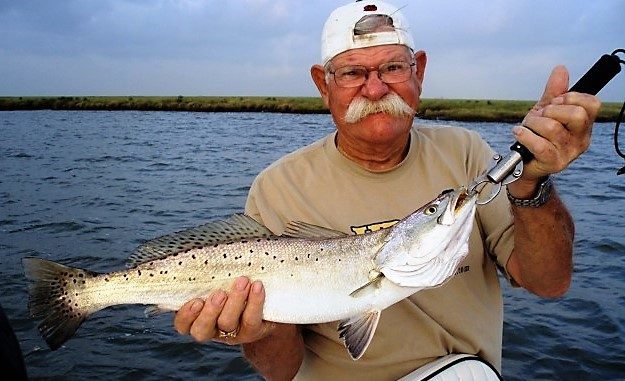
Reefs in Turner’s Bay speck hotspots, guide says
Through about the middle of November if there are favorable fishing conditions, the place to be to put speckled trout in the boat is the northern part of Calcasieu Lake —primarily Turner’s Bay.
Kirk Stansel says that timeframe is his favorite of the whole year because the area is loaded with fish then.
Stansel knows because he’s been a successful saltwater fishing guide for most of his life — the veteran charter boat captain and his brothers Guy and Bobby Joe own Hackberry Rod & Gun, located on the west side of Calcasieu Lake (888) 762-3391).
Speckled trout big and small roam the waters in that area, particularly the natural reefs and the Coastal Conservation Association of Louisiana artificial reef located in Turner’s Bay. An angler can get numbers there, and also maybe stick a wall-hanger.
“In November, everything’s hitting,” Stansel said, noting that speckled trout, redfish and flounder go on feeding sprees that time of year. “If somebody asked me what four weeks I’d want to go, I’d pick Oct. 15 to Nov. 15.”
Big Lake freshened up considerably because of Hurricane Harvey — he said 20 inches of rain fell in Hackberry.
But Calcasieu Lake, he said, “is just now starting to salt back up. The fishing’s good on calm days.”
Barring unseasonably heavy rains in October, the sprawling lake system should be in great shape, which means anglers need to point the bow of their boat to Turner’s Bay.
“When the cold fronts start hitting, baitfish (and shrimp) come out of the marsh,” he said. “The water temperature drops and the fish eat. It’s that time of the year.”
If you don’t have GPS coordinates for the CCA or natural reefs, marine electronics are crucial to finding the spots that hold fish in Turner’s Bay, Stansel said.
“If you don’t have a GPS for them, you have to have a sonar, because even a 1-foot rise or 1-foot drop makes a difference. There are humps up there that make a 2- to 3-foot difference,” he said.
Fish the reefs, which can be anywhere from 3- to 8-feet deep, with soft plastics such as watermelon/red (his favorite color for that time of year) Hackberry Hustler or a MirrOLure Lil John with chartreuse in it.
The size of leadhead depends on if the water’s on the cold side or the warm side. If it’s colder, use a ¼-ounce because the speckled trout generally are deeper, and a 5/16-ounce if the water’s warm.
Numbers of speckled trout can be caught on the reefs, but big speckled trout can be caught along the shorelines after a major cold because baitfish and shrimp are forced out of the marsh.
“I’m usually going to fish the lee side where there’s no wind but I’ve caught on the windy side. It blows the bait in there, so don’t shy away from the windward shoreline. It can be good,” Stansel said.
Look for birds working or the presence of mullet, he said, and concentrate on that area for big trout and redfish.
“If you just go to catch fish, fish the reefs where the birds are working,” he said. “If you want to target bigger trout, fish the shoreline.”
He targets the shoreline mostly with topwaters — his favorites are chartreuse Skitterwalks, but he also feeds them MirrOdines and Corkys.
“If you find a concentration of baitfish, target the area. If they’re on the shoreline, you’re going to find big fish,” he said.
November also is the peak of the flounder run, he said. Fish points and pockets with a lime chartreuse Gulp Mullet on a 5/16-ounce leadhead, he said.
Wherever you fish, it’s often best on a falling tide, Stansel said.